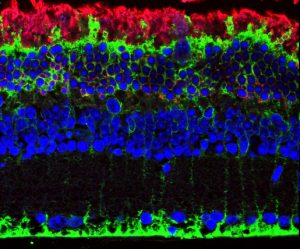Retinitis pigmentosa affects 1 in 3,500 individuals, who undergo progressive loss of vision, and for which currently there is no cure. Our approach aims to regenerate the photoreceptors, specific cell type in the retina, which respond to light.
We transplanted adult stem cells isolated from the bone marrow of mice and we observed fusion of these cells with Müller glia, a type of retinal glial cells which has a variety of functions. The Wnt signaling pathway is activated in the bone marrow cells before they are transplanted. We observed enhanced survival and proliferation of the hybrids as well as their reprogramming into intermediate photoreceptor precursors, which finally differentiate into photoreceptors. We demonstrated that this type of cell transplantation can rescue the retinal degeneration phenotype in retinitis pigmentosa mice.
Although the mammalian nervous system is unable to replace neuron lost due to degeneration, our findings suggest that photoreceptors can be generated by the reprogramming of Müller glia. In the future, this approach may have the potential to be used as a strategy for reversing retinal degeneration and cure blindness.
Reference
Sanges D, Simonte G, Di Vicino U, Romo N, Pinilla I, Nicolas M & Cosma MP 2016, ‘Reprogramming Muller glia via in vivo cell fusion regenerates murine photoreceptors’, Journal Of Clinical Investigation, 126, 8, 3104 – 3116.
